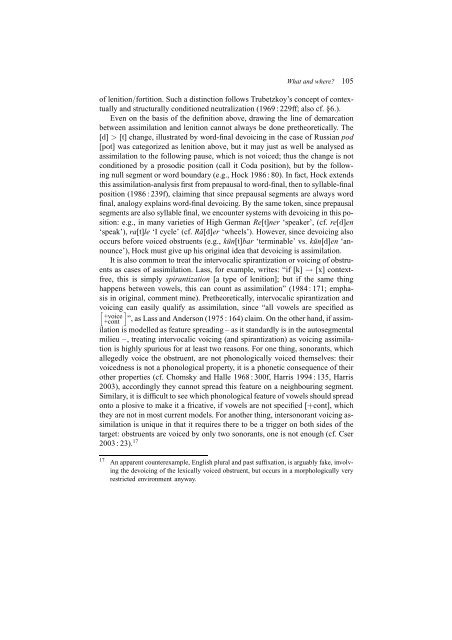What and where? Péter Szigetvári - SEAS
What and where? Péter Szigetvári - SEAS
What and where? Péter Szigetvári - SEAS
Create successful ePaper yourself
Turn your PDF publications into a flip-book with our unique Google optimized e-Paper software.
<strong>What</strong> <strong>and</strong> <strong>where</strong>? 105<br />
of lenition/fortition. Such a distinction follows Trubetzkoy’s concept of contextually<br />
<strong>and</strong> structurally conditioned neutralization (1969 : 229ff; also cf. §6.).<br />
Even on the basis of the definition above, drawing the line of demarcation<br />
between assimilation <strong>and</strong> lenition cannot always be done pretheoretically. The<br />
[d] > [t] change, illustrated by word-final devoicing in the case of Russian pod<br />
[pot] was categorized as lenition above, but it may just as well be analysed as<br />
assimilation to the following pause, which is not voiced; thus the change is not<br />
conditioned by a prosodic position (call it Coda position), but by the following<br />
null segment or word boundary (e.g., Hock 1986 : 80). In fact, Hock extends<br />
this assimilation-analysis first from prepausal to word-final, then to syllable-final<br />
position (1986 : 239f), claiming that since prepausal segments are always word<br />
final, analogy explains word-final devoicing. By the same token, since prepausal<br />
segments are also syllable final, we encounter systems with devoicing in this position:<br />
e.g., in many varieties of High German Re[t]ner ‘speaker’, (cf. re[d]en<br />
‘speak’), ra[t]le ‘I cycle’ (cf. Rä[d]er ‘wheels’). However, since devoicing also<br />
occurs before voiced obstruents (e.g., kün[t]bar ‘terminable’ vs. kün[d]en ‘announce’),<br />
Hock must give up his original idea that devoicing is assimilation.<br />
It is also common to treat the intervocalic spirantization or voicing of obstruents<br />
as cases of assimilation. Lass, for example, writes: “if [k] → [x] contextfree,<br />
this is simply spirantization [a type of lenition]; but if the same thing<br />
happens between vowels, this can count as assimilation” (1984 : 171; emphasis<br />
in original, comment mine). Pretheoretically, intervocalic spirantization <strong>and</strong><br />
voicingcan easily qualify as assimilation, since “all vowels are specified as<br />
+voice<br />
+cont ”, as Lass <strong>and</strong> Anderson (1975 : 164) claim. On the other h<strong>and</strong>, if assimilation<br />
is modelled as feature spreading – as it st<strong>and</strong>ardly is in the autosegmental<br />
milieu –, treating intervocalic voicing (<strong>and</strong> spirantization) as voicing assimilation<br />
is highly spurious for at least two reasons. For one thing, sonorants, which<br />
allegedly voice the obstruent, are not phonologically voiced themselves: their<br />
voicedness is not a phonological property, it is a phonetic consequence of their<br />
other properties (cf. Chomsky <strong>and</strong> Halle 1968 : 300f, Harris 1994 : 135, Harris<br />
2003), accordingly they cannot spread this feature on a neighbouring segment.<br />
Similary, it is difficult to see which phonological feature of vowels should spread<br />
onto a plosive to make it a fricative, if vowels are not specified [+cont], which<br />
they are not in most current models. For another thing, intersonorant voicing assimilation<br />
is unique in that it requires there to be a trigger on both sides of the<br />
target: obstruents are voiced by only two sonorants, one is not enough (cf. Cser<br />
2003 : 23). 17<br />
17 An apparent counterexample, English plural <strong>and</strong> past suffixation, is arguably fake, involving<br />
the devoicing of the lexically voiced obstruent, but occurs in a morphologically very<br />
restricted environment anyway.
















